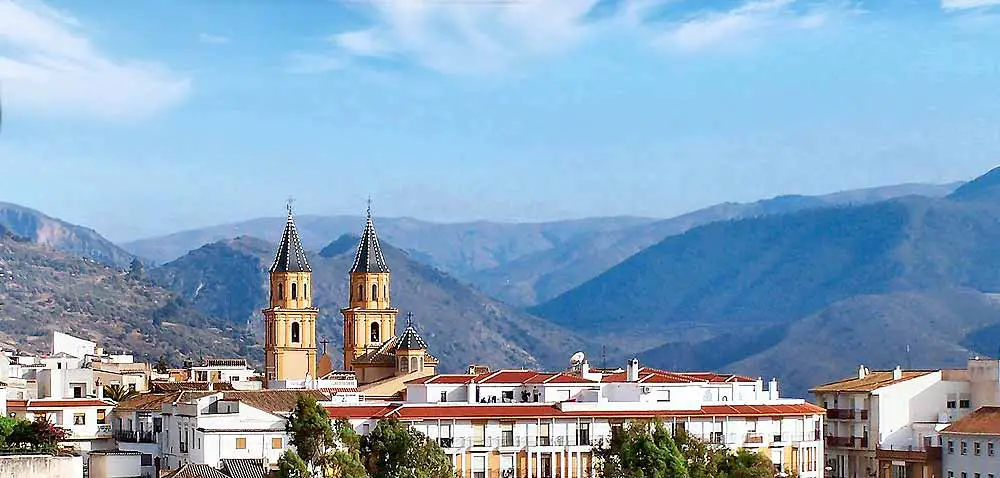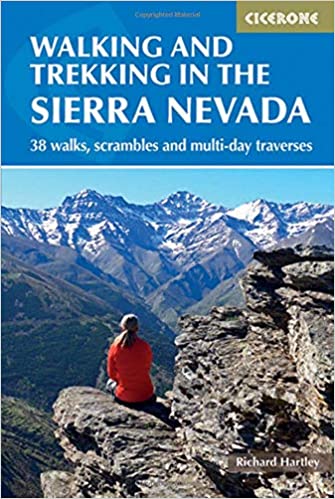The Village of Órgiva
Órgiva, the Fragrant Valley of the Alpujarras...
Surrounded by countryside, Órgiva's beautiful valley is an excellent base for exploring the Alpujarras. Its orange, olive, and lemon groves, together with an abundance of pomegranates, bougainvillea, morning glory, and jasmine bring an unrivaled color and fragrance to this sunny land.
Protected by the towering Sierra Nevada mountains to the north and the Sierras de Lújar and Contraviesa to the south, Órgiva is a rural paradise.
Check out the other Alpujarra villages: Lanjarón - Pampaneira - Bubión - Capileira - Pitres - Trevélez
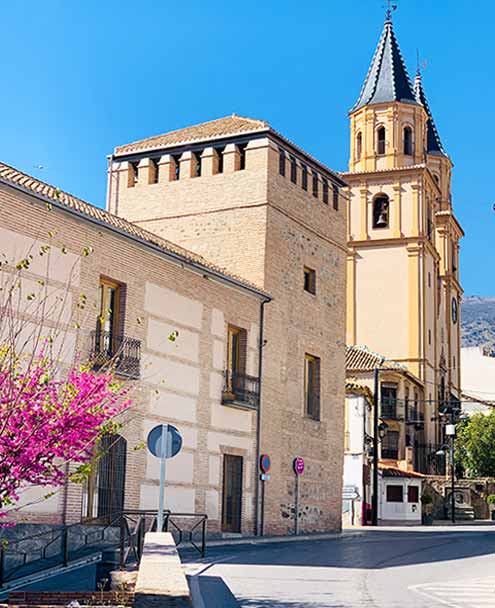
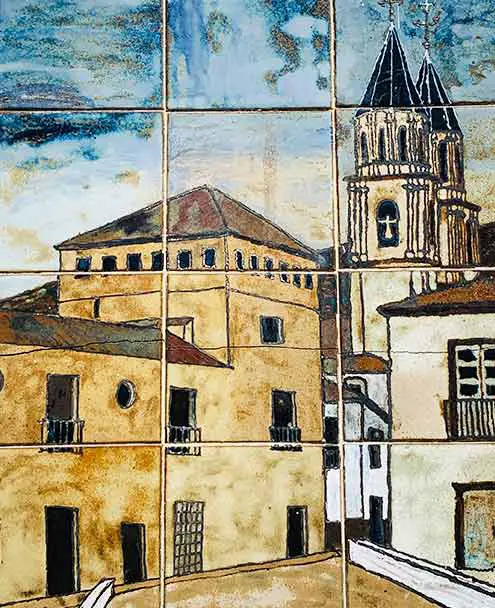
** The Beautiful Iglesia de Expectación & Conde Palace in Órgiva
A village once fit for a king (Órgiva was home to Boabdil, the last sultan of the Nasrid kingdom of Granada), today it is considered the capital and commercial center for the entire Alpujarra region.
Órgiva's prime location connects it with four important areas of Granada. Four roads depart from here:
- the first links Las Alpujarras with Salobreña, Almuñécar, and the Costa Tropical to the south;
- the second heads west through Lanjarón and continues north to Granada;
- the third goes through Torviscón and the foothills of the Contraviesa coastal mountain range into the remote villages of the eastern Alpujarras;
- and the fourth winds north into the Sierra Nevada mountains, ascending to the storied towns of Pampaneira, Bubión, Capileira, and Trevélez.
Contents on This Page
- Órgiva, a Bohemian Paradise...
- Where is Órgiva?
- Where to Stay in Órgiva?
- What to Do in Órgiva?
- Órgiva's Historic District
- Visit the Top Sites in Órgiva
- Visit the Órgiva Market
- Join a Tour to Órgiva
- The Best Places to Eat!
- Hiking Trails Around Órgiva
- Driving Over Lemons in Órgiva
- The Tourist Office
- When to Visit Órgiva
- How to Arrive
- The History of Órgiva & the Alpujarras
Órgiva, a Bohemian Paradise...
Being the largest and most bustling village in the Alpujarras and enjoying a milder climate than its neighbors, Órgiva has become home to many different nationalities over the years. It's this unique combination of cultures and customs that has especially drawn people of a more alternative lifestyle. Lovers of nature, spirituality, and simplicity thrive here.Village life in Órgiva can also be quite inexpensive compared to the coastal areas, which offers another opportunity for more bohemian types. New construction is currently underway throughout the "old town" where many newcomers are buying up ancient, ruined homes and transforming them into something more modern.
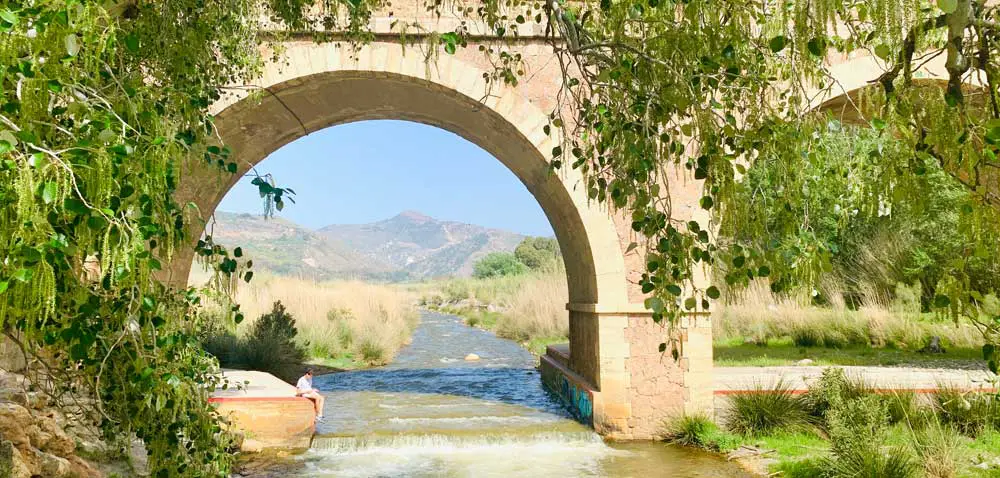
** View up the Guadalfeo River past the Órgiva Bridge
Other attractive aspects of this quaint village are its wonderful hiking trails, the Thursday market with its abundance of ecological and New Age items, the equestrian center, and the local campground with one of the best restaurants in town.
Where is Órgiva?
Órgiva is located on the southern slopes of the Sierra Nevada National Park (450 m above sea level) in a lush valley where two rivers meet, the Rio Guadalfeo and the Rio Chico. It is just 1-hour from the capital city of Granada, and 30-minutes to the Granada coast (Costa Tropical).It is also just 20-minutes from the famed Poqueira Gorge villages of Pampaneira, Bubión, and Capileira which have been designated as a Conjunto Histórico Artístico (site of particular artistic and historical importance), two of these villages have also been selected as one of the "Prettiest Villages in Spain".
Where to Stay in Órgiva
Órgiva is a popular destination because of its ancient Alpujarra culture, unique architecture, beautiful mountain views, and proximity to famed nature preserves. And, as such, it has quite a few nice places to stay.There are several nice hotels, rustic cottages, and the local campground which is very popular. You can also check hotels in the attractive village of Lanjarón, as it's only minutes away.
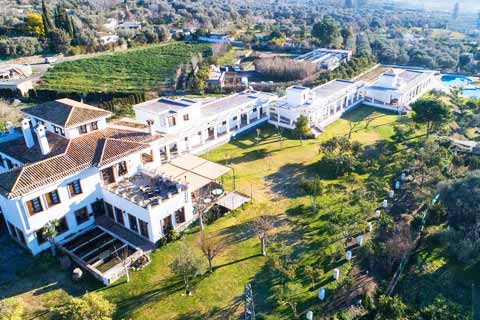
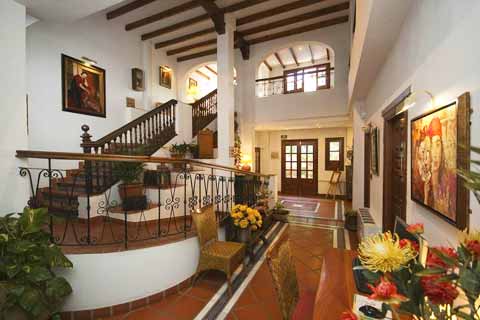
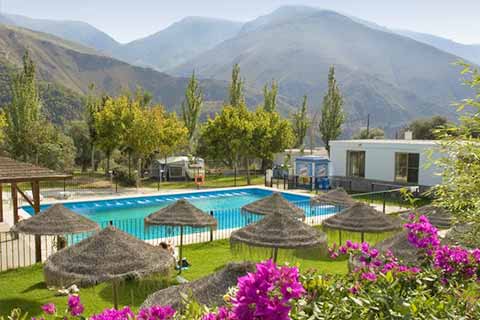
Rent a Cottage or Berber Home in Órgiva
Another option to consider, if you prefer more space, is renting a rustic cottage. There are several for rent in the area and people really enjoy the authenticity of staying in an ancient Berber home.There are two good sites for finding cottages ➜ Find a Cottage on Booking / Cottages on VRBO
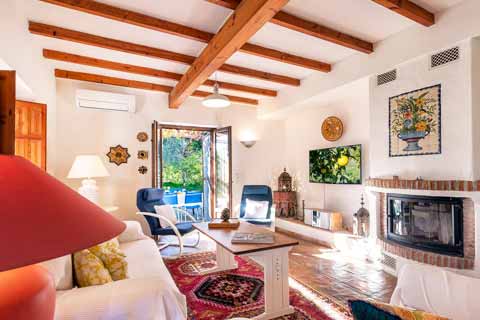
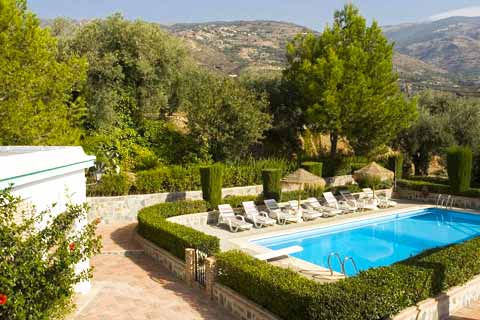
Trusted Booking / VRBO Partner
What to Do in Órgiva?
If you are passing through the area, a visit to Órgiva will only take you an hour or so. Visit the "top sites" below, wander through the old town's quaint streets and alleys, and enjoy a delicious Alpujarra meal in one of our recommended restaurants. We also encourage you to take advantage of the hiking while in town, the Órgiva trails are some of the best in the area.
1. Órgiva's Historic District
Órgiva shares similar architectural details with its neighbor to the north, Lanjarón. They are both traditional Alpujarra villages with the characteristic flat slate roofs, tinaos, and chimney pots but they tend to be more of a mix of Spanish and Moorish styles. As you move further up into the Poqueira Gorge, you will notice the style becoming more Moorish and even Berber (a group of pre-Muslim inhabitants).Like other nearby villages, Órgiva's old town is resplendent in brightly colored, flower-filled balconies, ancient fountains, and staggering views of its emblematic church spires around every corner.
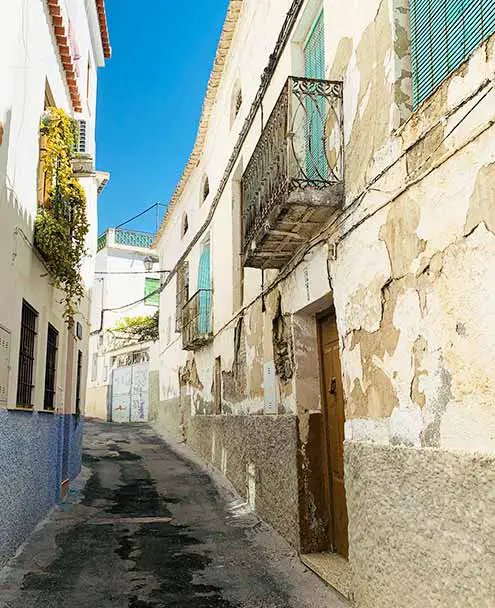
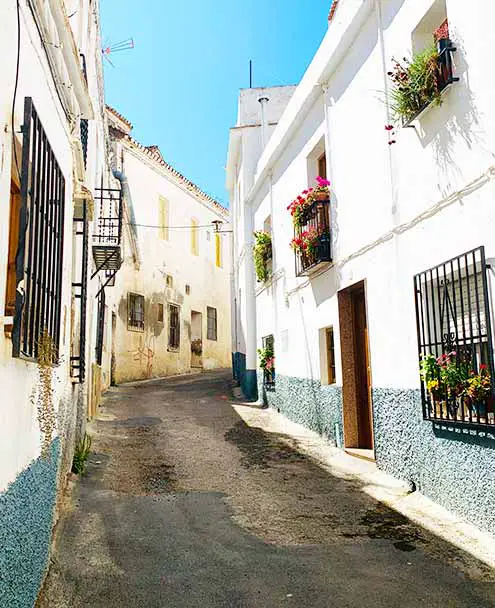
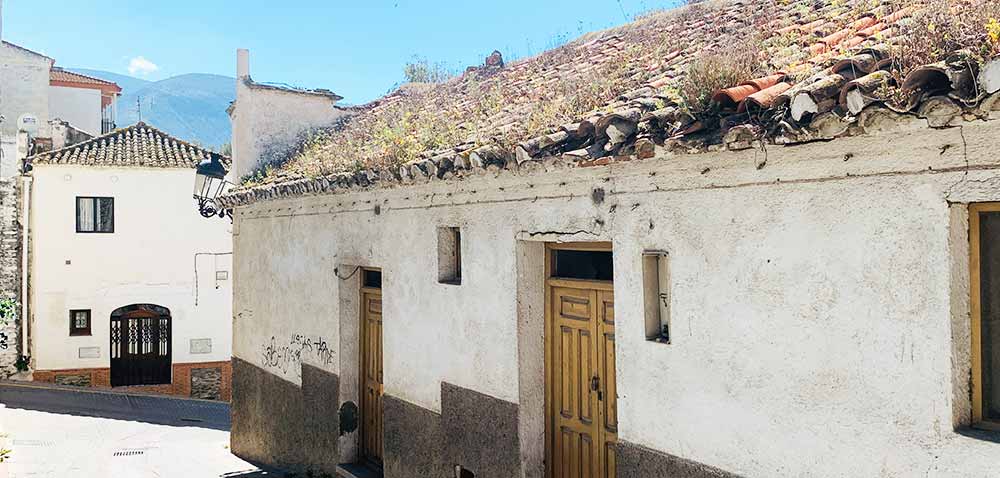
** Órgiva's Ancient Streets and Alleys
2. Órgiva's Top Sites - What not to Miss...
The top places to see while you're in the village of Órgiva are:
- Iglesia de Nuestra Señora de la Expectación -
Rising out of the village and soaring to the sky, you can see the symbolic church spires of the Iglesia de Nuestra Señora de la
Expectación from miles away.
Built upon the remains of an old Moorish mosque in 1500, this church worships the patron saint of the Alpujarras, the Santísimo Cristo de la Expiración or Christ of the Expiration.
A story has been told that during the Spanish Civil War, while the people of Órgiva sought shelter within the church, two bombs were dropped on it. Thankfully, the bombs never went off and gratitude has always been given to its beloved saint.
- Biblioteca Municipal / Sala Cervantina - Founded in 1953, it houses the Sala Cervantina which holds the
largest, most important collection about Don Quixote in Spain, making it a cultural treasure and the jewel of the Alpujarra.
It also houses a collection of over 600 books by Miguel de Cervantes.
- Tinao Alpujarreño - Don't miss the typical "Tinao Alpujarreño" located within the winding streets of the old town. This is an excellent example of ancient Moorish architecture that has its roots in the Alpujarras.
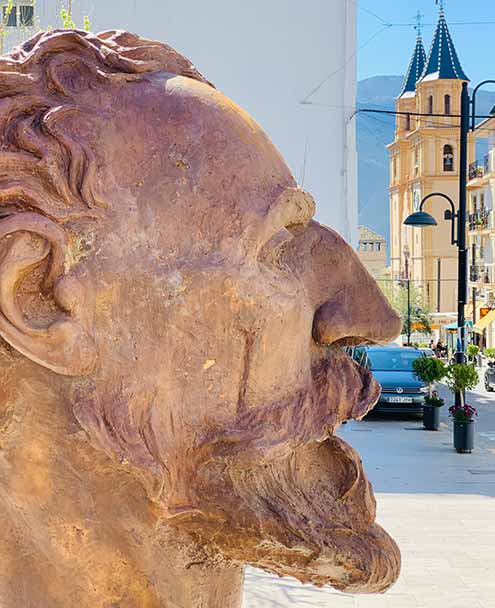
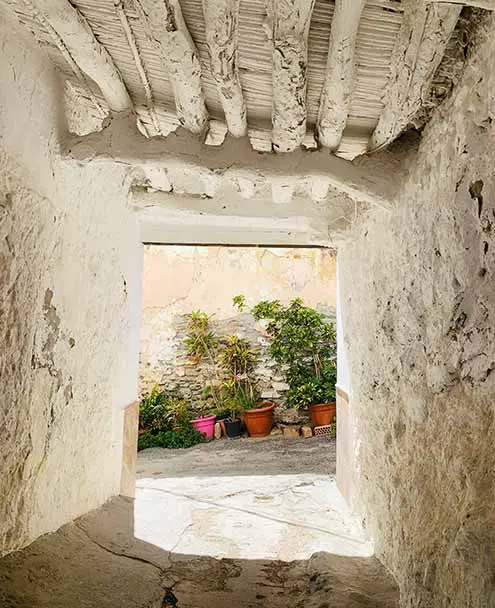
** A Bust of Don Quixote & Tinao Alpujarreño in Órgiva
- Plaza de La Alpujarra - Built in 2004, the main plaza in Órgiva is lively and pretty. Here you will find the town's tourist office, cafes, shops, and the daily market. Beautifully tiled representations of each of the villages of the Alpujarras adorn its walls.
- Statues - Keep an eye out for various artwork throughout the streets of Órgiva. Two pieces that stand out are the Bust of Don Quixote de la Mancha across from the Ayuntamiento, and the bronze statue "Lorca and Falla" (famous poet Federico García Lorca and famed musician Manuel de Falla) across from the church.
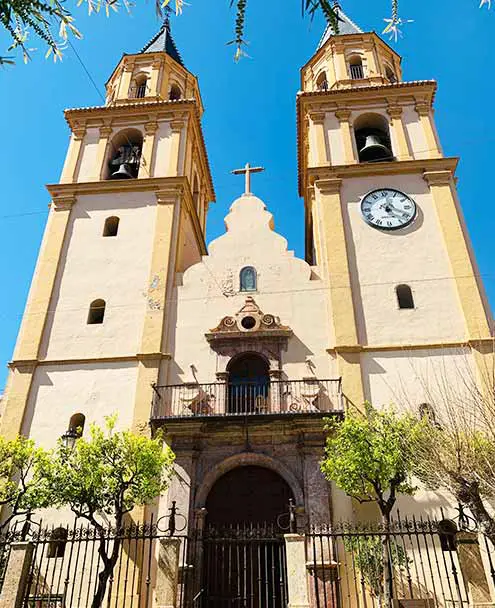
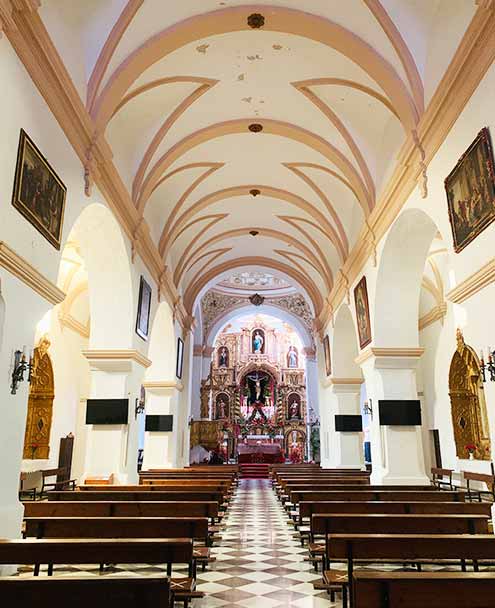
** Iglesia de Nuestra Señora de la Expectación in Órgiva
- Casa Palacio de Los Condes de Sástago - This castle with beautiful Arabic details was built by the family of the Great Captain in the 16th and 17th centuries. During the Moorish rebellion, the governor and Christian people of Órgiva hid in the tower while under heavy bombardment. They fiercely defended their castle and in the end, it possessed the only standing tower in the Alpujarras.
- La Ermita de San Sebastián - Built on the remains of an Arabic fortress in the Barrio Alto with views of the village and countryside below, you will find this historic hermitage. After the Bubonic Plague which decimated the area, this Ermita was built in 1589 to give thanks to the town's patron saint, San Sebastián.
- Molino de Benizalte - A mill built in the sixteenth century on the banks of the Rio Chico and later restored in 2009. The Virgen de las Nieves is a focus.
- El Castillejo de Órgiva - On the top of a hill, almost 900 meters above sea level, are the remains of an ancient Muslim fortress, the Castillejo de Órgiva. It's not an easy climb, but it's still possible to reach what's left of the main tower of this ancient fortification.
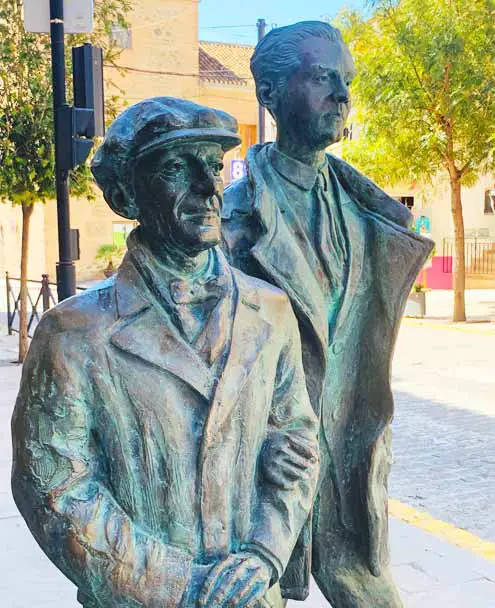
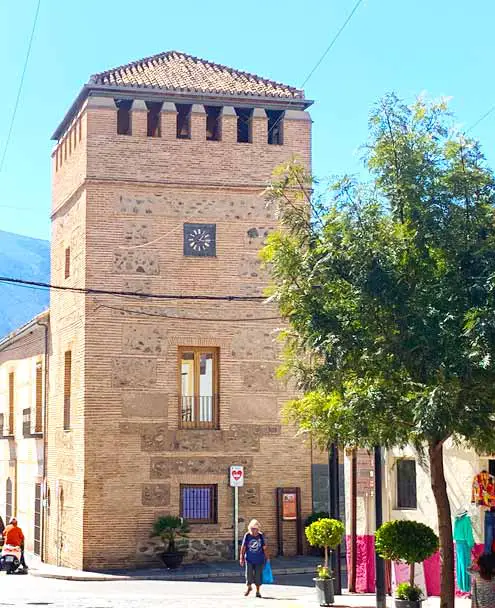
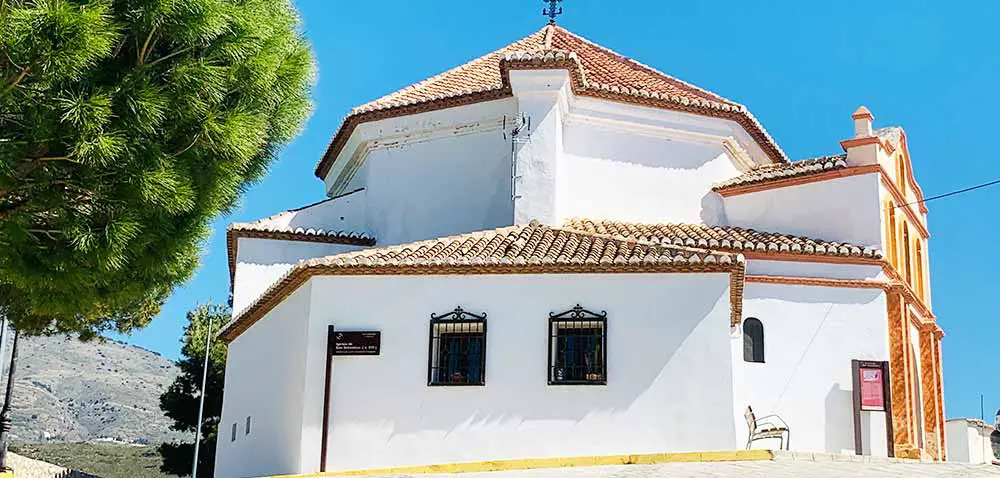
Lorca & Falla, Palacio de los Condes, Ermita de San Sebastián
3. Take a Stroll through the Órgiva Market!
The Órgiva market is known for being one of the best in the Alpujarras, you can always rely on it for having an impressive range of items in an ever-growing collection of stalls and tents.Because of the bohemian nature of this village, all sorts of interesting items are for sale; from fruits and vegetables, spices, plants, flowers, and herbs... to clothing, second-hand wares, crystals, incense, and jewelry.
Every Thursday, between 10:00 and 14:00, you will find this bustling hive of activity just past the main plaza... in the municipal parking area.
If you miss it, don't worry, there are local markets in each of the nearby Alpujarra towns:
- Pampaneira (Monday)
- Bubión (Tuesday and Saturday)
- Capileira (Tuesday)
- Cañar (Wednesday)
- Trevélez (Wednesday)
- Lanjarón (Friday)
4. Tours to Órgiva from Granada & Adventure Tours
If you're not sure about traveling around the area yourself, you could join several tours that leave daily from Granada. Tour guides will plan the visit, stop in the prettiest Alpujarra villages, provide a nice lunch, and get you back by evening.Or, if you're feeling adventurous, check out these adventure tours that operate in the Alpujarras; Rafting, hiking, cycling, or even a Four-Wheel Drive Safari are among your choices... See them all here...
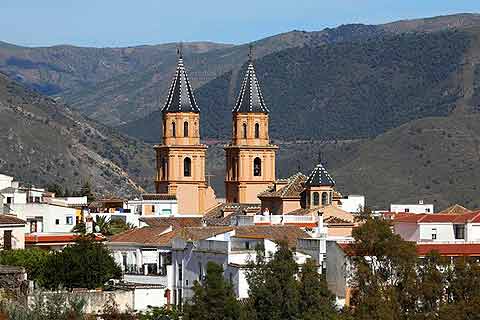
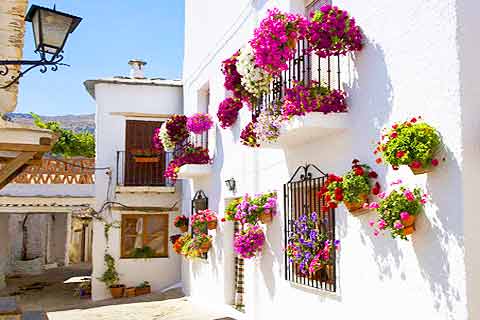
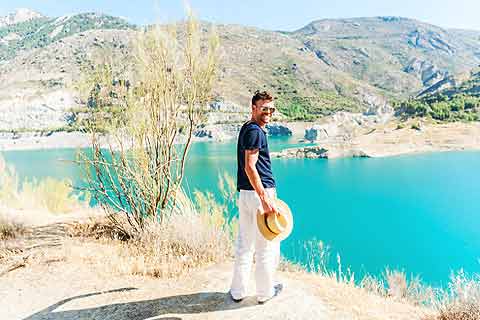
4. Hiking Trails Around Órgiva
Órgiva is set in a gorgeous valley surrounded by fruit orchards and olive groves. The waters of the Guadalfeo river run down from the Sierras and join with the River Chico just outside of town.Because of the relatively flat surroundings, fresh mountain air, beautiful vistas, and flowing rivers and water canals, the hiking around Órgiva is sublime. Take a look at the two most popular routes below.
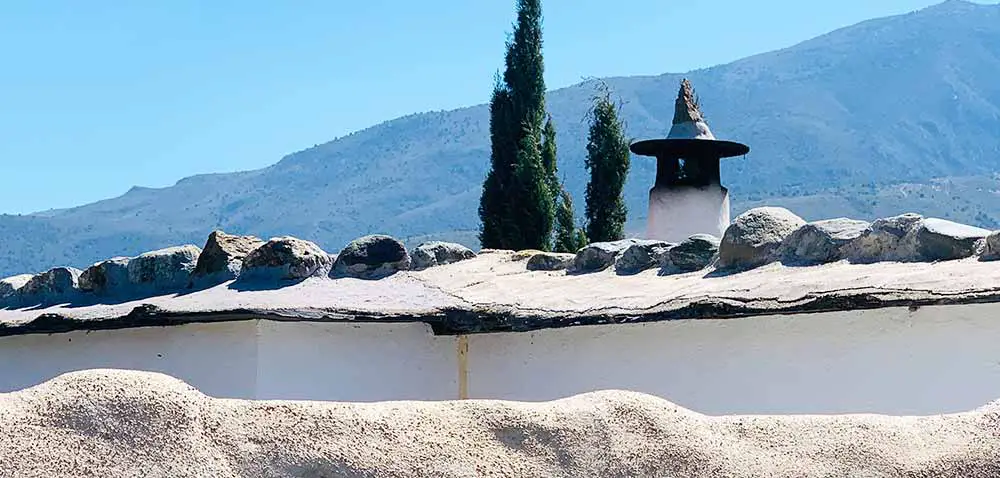
** Typical Chimney Pots on the Ruta de Los Olivos in Órgiva
- Ruta de Los Olivos Centenarios - Starting in the Alpujarra Plaza in the center of Órgiva, this 9 km circular route (~2 hours) leads you through stunning countryside, past hundred-year-old olive trees and lemon orchards, along the banks of the Guadalfeo river, and enjoys impressive views of the surrounding Sierra de Lújar, Sierra Nevada, and Contraviesa.
Find more detailed information here: Ruta de Los Olivos Centenarios.
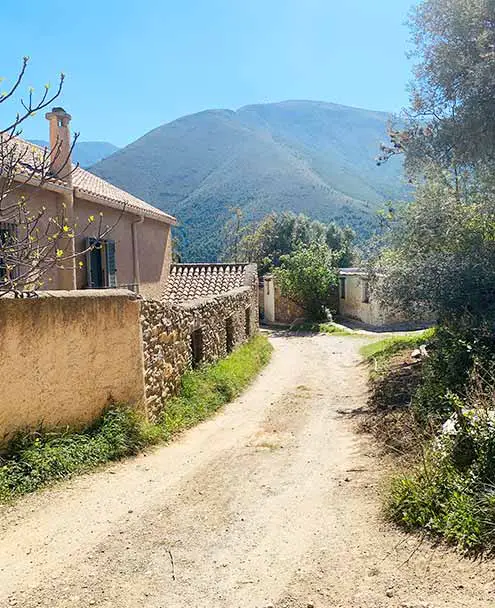
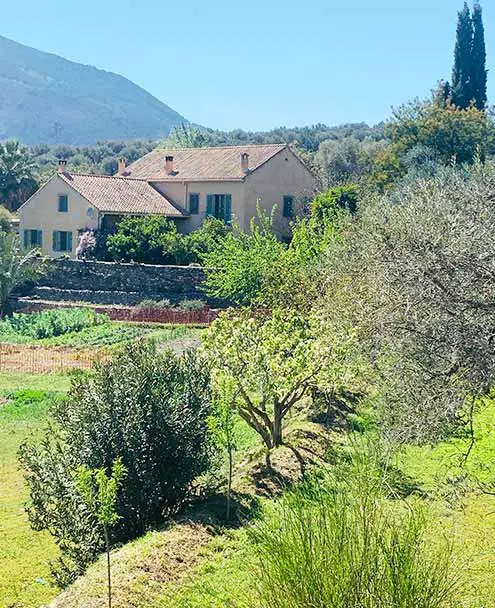
** Beautiful Scenery on the Ruta de Los Olivos in Órgiva
- Sendero Minero - This 3-hour circular hike leaves Órgiva and ascends into the Sierra de Lujar mountains where you will find what is left of the iron-ore mines that closed in 1929. At its peak (El Mirador de Los Mineros) you can see the village of Órgiva, the Guadalfeo river valley, and the Mediterranean Sea shimmering in the distance.
Find more detailed information here: Ruta de Los Mineros y Sierra de Lujar Circular.
Driving Over Lemons in Órgiva, and Other Recommended Books!
Driving over Lemons is a story of courage, of finding oneself in the struggles of the day. It's about taking a leap of faith, moving to a new land, starting a new life, and in the process finding a great inner peace.The author, Chris Stewart, bought an old farm near Órgiva and details his and his family's adventures with grace and humor. The success of his book put a spotlight on this quirky Alpujarra village and people from all over Europe have been flocking here ever since.
The Best Places to Eat in Órgiva!
Typical dishes that are popular in Órgiva are thick hearty stews, trout, the Plato Alpujarreño (eggs, fried peppers, black pudding, sausage, cured ham, and fried potatoes), goat, and fresh salads.Find our two favorite restaurants in Órgiva below... El Limonero and El Molino are also very good!


Tourist Office / Ayuntamiento
Opening Hours (Winter):
Tuesday - Saturday: 10:00 - 14:00 & 17:00 - 21:00
Sunday: 10:00 - 14:00
Opening Hours (Summer):
Tuesday - Saturday: 10:00 - 14:00 & 18:00 - 20:00
Sunday: 10:00 - 14:00
Telephone: 958 78 42 66
Email: orgivaturismo@gmail.com
Address: - The tourist office is located on the western end of the Plaza de la Alpujarra.
ÓRGIVA AYUNTAMIENTO
Opening Hours:
Monday to Friday: 8:00 – 14:00
Address - Av. González Robles, 20, 18400 Órgiva, Granada
Telephone: 958 78 52 12
Website: www.ayuntamientodeorgiva.es/
Village Information
| Region: | Las Alpujarras |
| Post Code: | 18400 |
| # of inhabitants: | ~ 5370 |
| Inhabitants: | Orgiveños |
| Distance to Granada: | 55 km (55-minutes) |
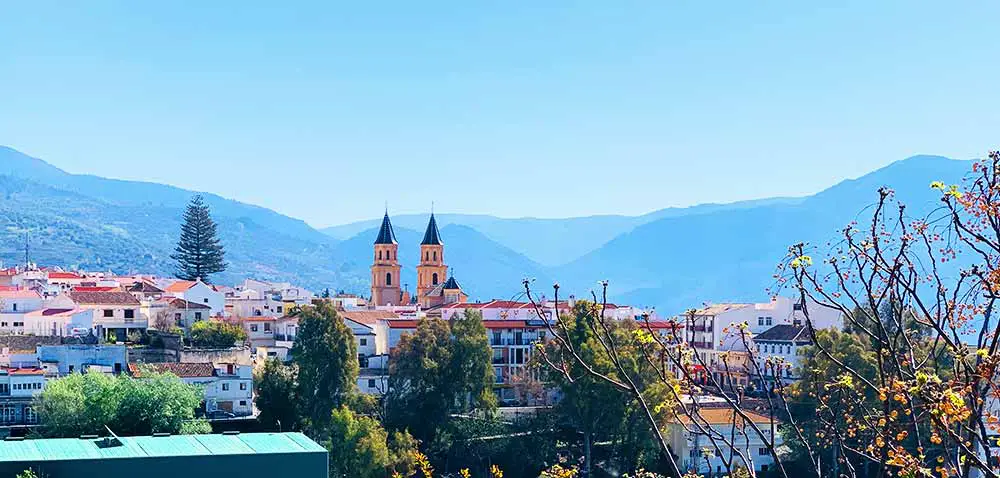
** View of Órgiva from the Road to the Poqueira Gorge
Other Important Information About Órgiva
1. Órgiva Fiestas
It's main fiestas are:San Sebastián - January 20th - A celebration in honor of the Patron Saint of Órgiva which includes a procession through town with San Sebastián and the Virgin of Aurora.
Feria Grande (Royal Fairs and Festivities) - For four days at the end of September and the beginning of October the Orgiveños celebrate in style. Festivities include competitions (Parade and Float Competitions and the International Migas Competition), exhibitions, concerts, parades, food-tasting, theatrical presentations, music, and dancing. Children will enjoy parties, popular games, bouncy castles, and crafts.
Tourism, Craft, and Food Fair (Made in the Alpujarra) - During the week of Semana Santa, this fair highlights typical products made in the Alpujarra, such as food, wines, and crafts. It takes place in the Órgiva fairground.
2. When to Visit Órgiva
At 450m above sea level, Órgiva has a milder climate than other Alpujarra towns. But if you like a cozy, mountain feel, come in January when the air is crisp and the smells of smokey fires and roasted chestnuts fill the air.Fall and spring are also good times to visit because the temperature is cool and it's the perfect time for hiking.
- During May and October, you are most likely to experience good weather with pleasant average temperatures that fall between 20 degrees Celsius (68°F) and 25 degrees Celsius (77°F).
- The hottest season is in June, July, August, and September.
- Lanjarón has dry periods in June, July, August, and September.
- The warmest month is July with an average maximum temperature of 33°C (91°F).
- The coldest month is January with an average maximum temperature of 12°C (53°F).
- November is the wettest month.
- July is the driest month.
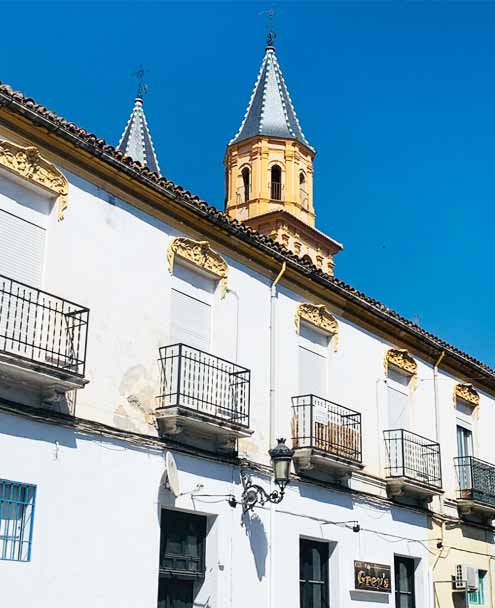
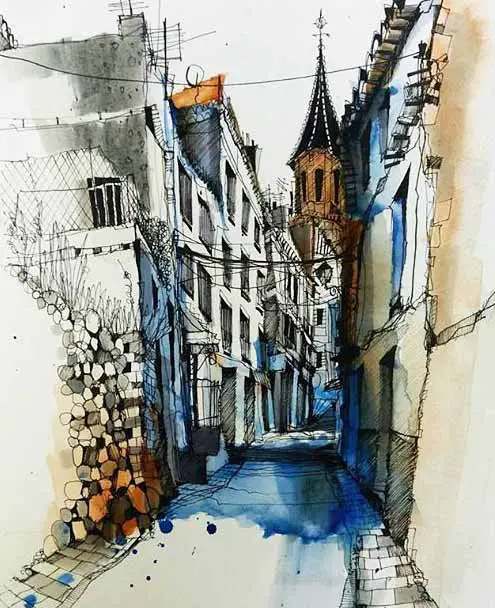
** Scenes of the Órgiva Church Spires
3. How to Arrive
Órgiva is located just 54 kilometers (55-minutes) south of the city of Granada and the Granada airport.
- From Granada - Driving south from Granada on the main N-323 motorway towards the coast, look for the signs indicating "Las Alpujarras"
and "Órgiva" as you pass over the mountains. Exit the motorway and head east. Roads will be clearly marked.
- From Malaga - take the A-7 motorway (or the older, slower, and more scenic N-340 motorway that runs parallel to the A-7) east towards Almuñécar, Motril, and Almería. In about 20 minutes after passing Almuñécar and when you reach Salobreña, take motorway N-323 towards Granada. Órgiva is located only 32 kilometers from Salobreña. As you climb the mountains you will pass a dam and a lake on your left. Look for signs indicating "Las Alpujarras" and "Órgiva". Exit the motorway and head east.
- From Almería - take the N-340 motorway west towards Málaga and Almuñécar. When you reach Salobreña (before Almuñécar), take motorway N-323 towards Granada. Follow the directions noted above.
Save money on your next trip with our favorite travel websites!
| Find the Cheapest Hotels: | |
| The Largest Selection of Villas & Apartments: | |
| Cheapest, Most Reliable Car Rentals: | |
| Best Bus & Train Fares: | |
| Huge Selection of the BEST Tours & Activities | |
| Discount Tickets to Museums & Attractions | |
4. Parking
Parking in Órgiva is a bit tricky. If you come in from the south, past the main church (with its recognizable spires), there is a small parking lot on the left side. If you continue north, past the Ayuntamiento and Plaza Alpujarra you will reach the town's largest parking lot at the top of town. This lot won't be available on Thursdays, as it's also the location of the town's weekly market.
5. Órgiva - A Brief History...
- Órgiva was founded in Roman times for mining and farming the fertile valley along the Guadalfeo River.
- After the invasion by the Moors in the 7th Century, it was ruled under the authority of Ugíjar.
- After losing Granada to the Catholic Monarchs in 1492, Órgiva was granted to the dethroned Moorish ruler, Boabdil.
- During Moorish rule, Órgiva was known as "Albacete de Órgiva", which stems from the Muslim word "Albastch" (meaning "plain").
- Later Órgiva played an important role in the war between the Moriscos and the Catholics when Abén Humeya organized an uprising against King Phillip ll. The Moriscos were finally expelled in 1609.
- Thereafter, Órgiva, as with the rest of the Alpujarra, was forgotten and left to languish in economic decline.
- Several interesting monuments of early days remain: the 16th Century Palace (Palacio del Duque del Arco) and the 16th Century Parish Church are the best preserved.
- Famous people who lived in Órgiva: Gonzalo Fernández de Córdoba, the Great Captain, the Duke of Sessa, the Córdoba and Ayala families, the Marquis of Valenzuela and the Counts of Sástago.
